The Art and Science of Nursing
VerifiedAdded on 2021/05/31
|13
|3341
|26
AI Summary
Contribute Materials
Your contribution can guide someone’s learning journey. Share your
documents today.
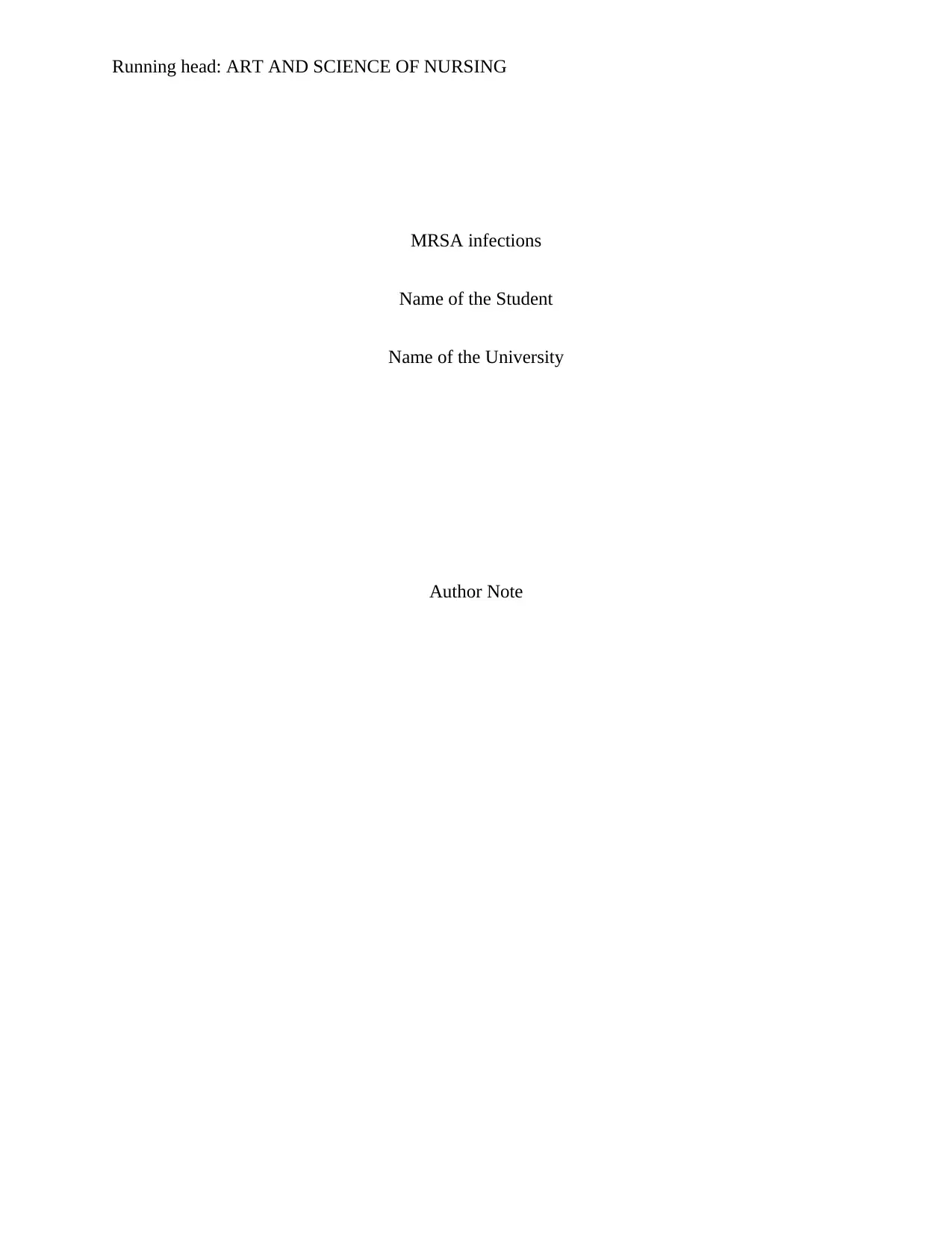
Running head: ART AND SCIENCE OF NURSING
MRSA infections
Name of the Student
Name of the University
Author Note
MRSA infections
Name of the Student
Name of the University
Author Note
Secure Best Marks with AI Grader
Need help grading? Try our AI Grader for instant feedback on your assignments.
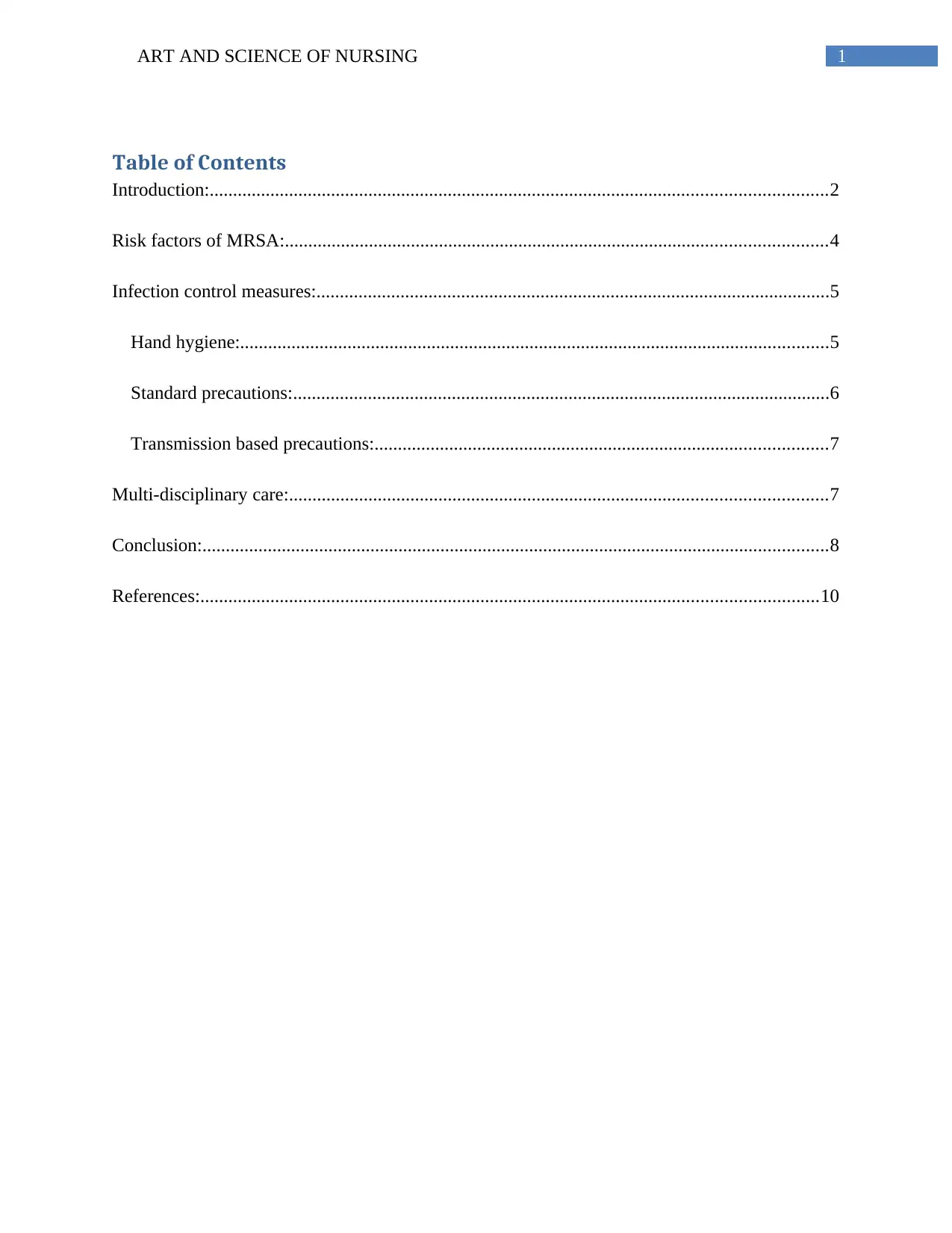
1ART AND SCIENCE OF NURSING
Table of Contents
Introduction:....................................................................................................................................2
Risk factors of MRSA:....................................................................................................................4
Infection control measures:..............................................................................................................5
Hand hygiene:..............................................................................................................................5
Standard precautions:...................................................................................................................6
Transmission based precautions:.................................................................................................7
Multi-disciplinary care:...................................................................................................................7
Conclusion:......................................................................................................................................8
References:....................................................................................................................................10
Table of Contents
Introduction:....................................................................................................................................2
Risk factors of MRSA:....................................................................................................................4
Infection control measures:..............................................................................................................5
Hand hygiene:..............................................................................................................................5
Standard precautions:...................................................................................................................6
Transmission based precautions:.................................................................................................7
Multi-disciplinary care:...................................................................................................................7
Conclusion:......................................................................................................................................8
References:....................................................................................................................................10
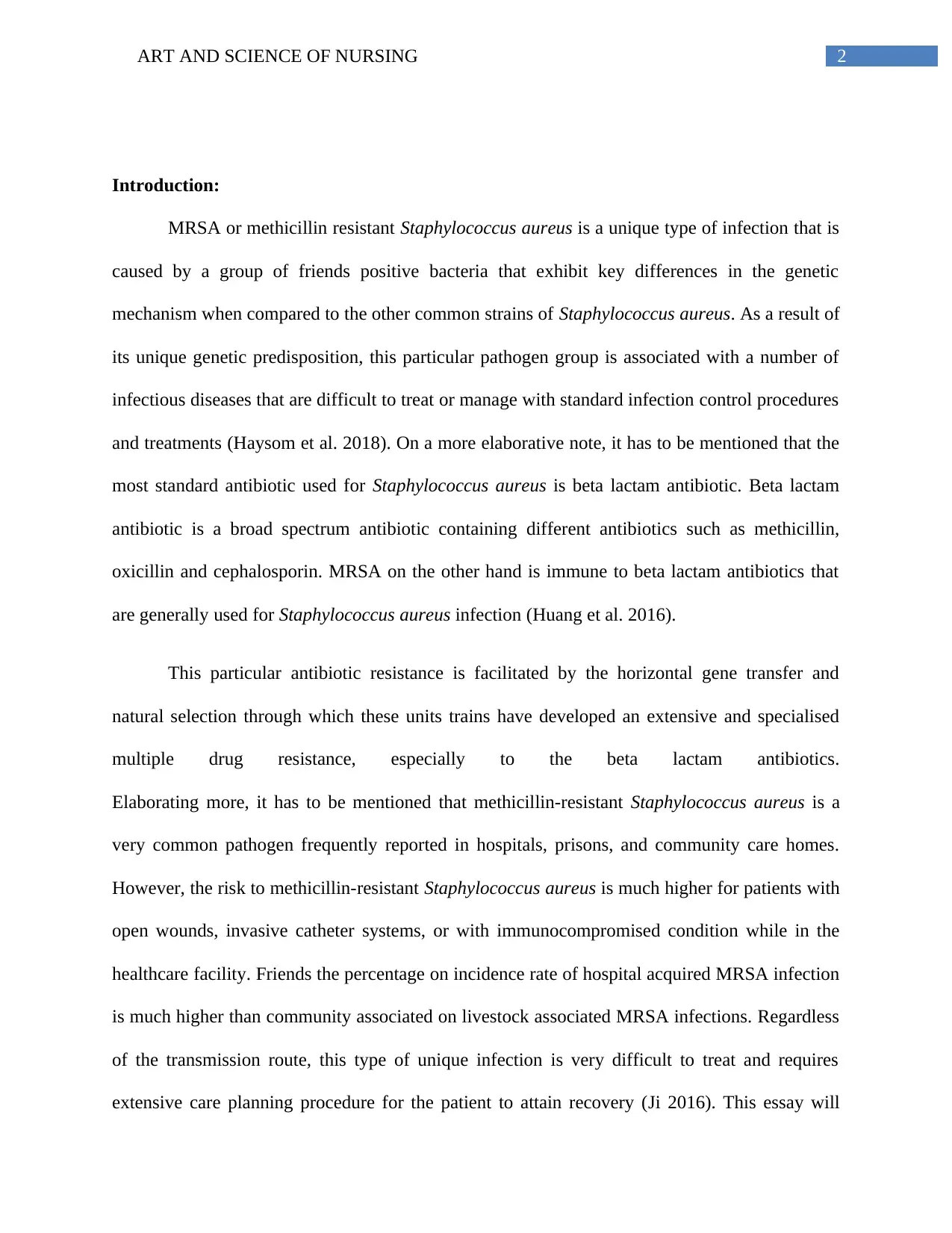
2ART AND SCIENCE OF NURSING
Introduction:
MRSA or methicillin resistant Staphylococcus aureus is a unique type of infection that is
caused by a group of friends positive bacteria that exhibit key differences in the genetic
mechanism when compared to the other common strains of Staphylococcus aureus. As a result of
its unique genetic predisposition, this particular pathogen group is associated with a number of
infectious diseases that are difficult to treat or manage with standard infection control procedures
and treatments (Haysom et al. 2018). On a more elaborative note, it has to be mentioned that the
most standard antibiotic used for Staphylococcus aureus is beta lactam antibiotic. Beta lactam
antibiotic is a broad spectrum antibiotic containing different antibiotics such as methicillin,
oxicillin and cephalosporin. MRSA on the other hand is immune to beta lactam antibiotics that
are generally used for Staphylococcus aureus infection (Huang et al. 2016).
This particular antibiotic resistance is facilitated by the horizontal gene transfer and
natural selection through which these units trains have developed an extensive and specialised
multiple drug resistance, especially to the beta lactam antibiotics.
Elaborating more, it has to be mentioned that methicillin-resistant Staphylococcus aureus is a
very common pathogen frequently reported in hospitals, prisons, and community care homes.
However, the risk to methicillin-resistant Staphylococcus aureus is much higher for patients with
open wounds, invasive catheter systems, or with immunocompromised condition while in the
healthcare facility. Friends the percentage on incidence rate of hospital acquired MRSA infection
is much higher than community associated on livestock associated MRSA infections. Regardless
of the transmission route, this type of unique infection is very difficult to treat and requires
extensive care planning procedure for the patient to attain recovery (Ji 2016). This essay will
Introduction:
MRSA or methicillin resistant Staphylococcus aureus is a unique type of infection that is
caused by a group of friends positive bacteria that exhibit key differences in the genetic
mechanism when compared to the other common strains of Staphylococcus aureus. As a result of
its unique genetic predisposition, this particular pathogen group is associated with a number of
infectious diseases that are difficult to treat or manage with standard infection control procedures
and treatments (Haysom et al. 2018). On a more elaborative note, it has to be mentioned that the
most standard antibiotic used for Staphylococcus aureus is beta lactam antibiotic. Beta lactam
antibiotic is a broad spectrum antibiotic containing different antibiotics such as methicillin,
oxicillin and cephalosporin. MRSA on the other hand is immune to beta lactam antibiotics that
are generally used for Staphylococcus aureus infection (Huang et al. 2016).
This particular antibiotic resistance is facilitated by the horizontal gene transfer and
natural selection through which these units trains have developed an extensive and specialised
multiple drug resistance, especially to the beta lactam antibiotics.
Elaborating more, it has to be mentioned that methicillin-resistant Staphylococcus aureus is a
very common pathogen frequently reported in hospitals, prisons, and community care homes.
However, the risk to methicillin-resistant Staphylococcus aureus is much higher for patients with
open wounds, invasive catheter systems, or with immunocompromised condition while in the
healthcare facility. Friends the percentage on incidence rate of hospital acquired MRSA infection
is much higher than community associated on livestock associated MRSA infections. Regardless
of the transmission route, this type of unique infection is very difficult to treat and requires
extensive care planning procedure for the patient to attain recovery (Ji 2016). This essay will
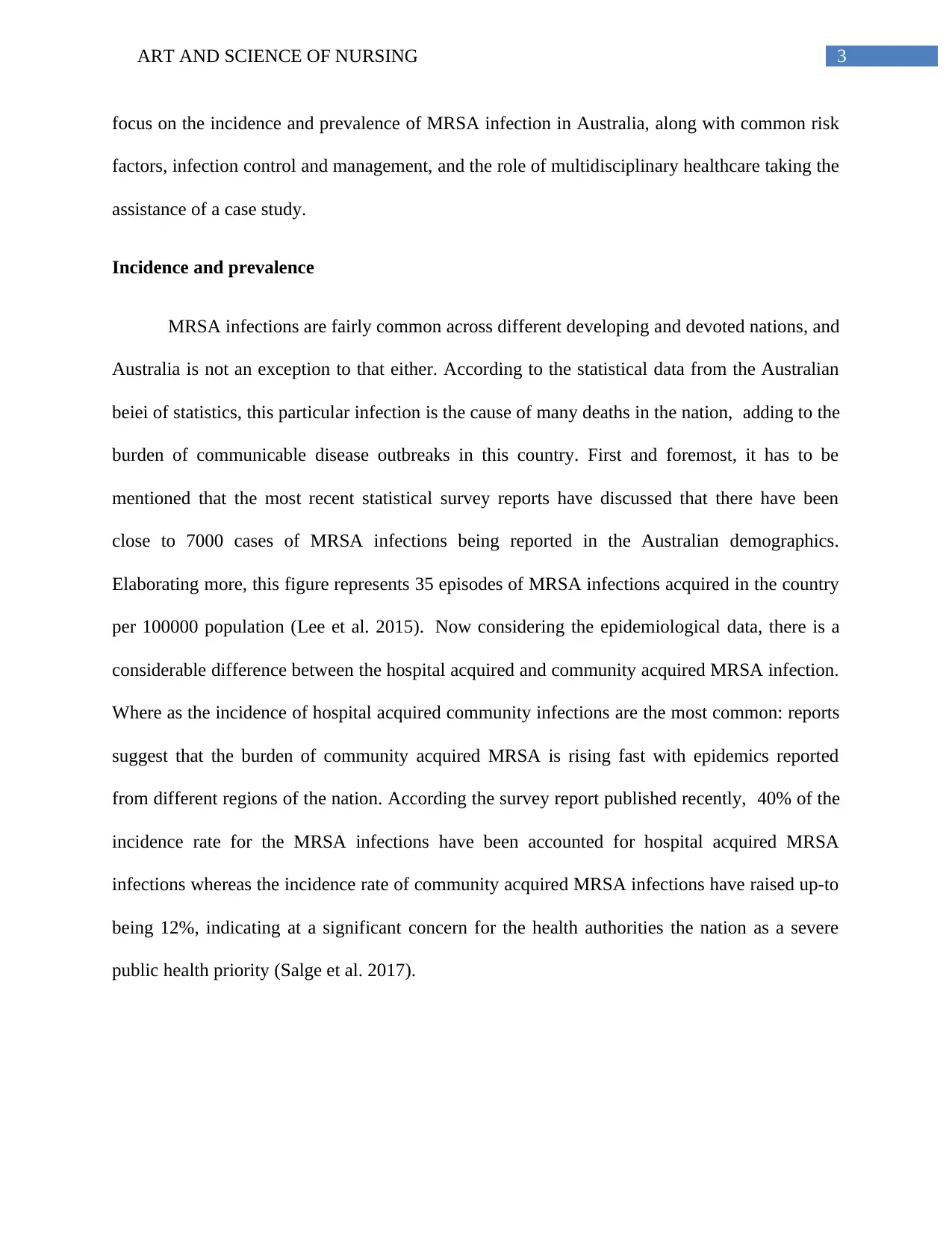
3ART AND SCIENCE OF NURSING
focus on the incidence and prevalence of MRSA infection in Australia, along with common risk
factors, infection control and management, and the role of multidisciplinary healthcare taking the
assistance of a case study.
Incidence and prevalence
MRSA infections are fairly common across different developing and devoted nations, and
Australia is not an exception to that either. According to the statistical data from the Australian
beiei of statistics, this particular infection is the cause of many deaths in the nation, adding to the
burden of communicable disease outbreaks in this country. First and foremost, it has to be
mentioned that the most recent statistical survey reports have discussed that there have been
close to 7000 cases of MRSA infections being reported in the Australian demographics.
Elaborating more, this figure represents 35 episodes of MRSA infections acquired in the country
per 100000 population (Lee et al. 2015). Now considering the epidemiological data, there is a
considerable difference between the hospital acquired and community acquired MRSA infection.
Where as the incidence of hospital acquired community infections are the most common: reports
suggest that the burden of community acquired MRSA is rising fast with epidemics reported
from different regions of the nation. According the survey report published recently, 40% of the
incidence rate for the MRSA infections have been accounted for hospital acquired MRSA
infections whereas the incidence rate of community acquired MRSA infections have raised up-to
being 12%, indicating at a significant concern for the health authorities the nation as a severe
public health priority (Salge et al. 2017).
focus on the incidence and prevalence of MRSA infection in Australia, along with common risk
factors, infection control and management, and the role of multidisciplinary healthcare taking the
assistance of a case study.
Incidence and prevalence
MRSA infections are fairly common across different developing and devoted nations, and
Australia is not an exception to that either. According to the statistical data from the Australian
beiei of statistics, this particular infection is the cause of many deaths in the nation, adding to the
burden of communicable disease outbreaks in this country. First and foremost, it has to be
mentioned that the most recent statistical survey reports have discussed that there have been
close to 7000 cases of MRSA infections being reported in the Australian demographics.
Elaborating more, this figure represents 35 episodes of MRSA infections acquired in the country
per 100000 population (Lee et al. 2015). Now considering the epidemiological data, there is a
considerable difference between the hospital acquired and community acquired MRSA infection.
Where as the incidence of hospital acquired community infections are the most common: reports
suggest that the burden of community acquired MRSA is rising fast with epidemics reported
from different regions of the nation. According the survey report published recently, 40% of the
incidence rate for the MRSA infections have been accounted for hospital acquired MRSA
infections whereas the incidence rate of community acquired MRSA infections have raised up-to
being 12%, indicating at a significant concern for the health authorities the nation as a severe
public health priority (Salge et al. 2017).
Secure Best Marks with AI Grader
Need help grading? Try our AI Grader for instant feedback on your assignments.
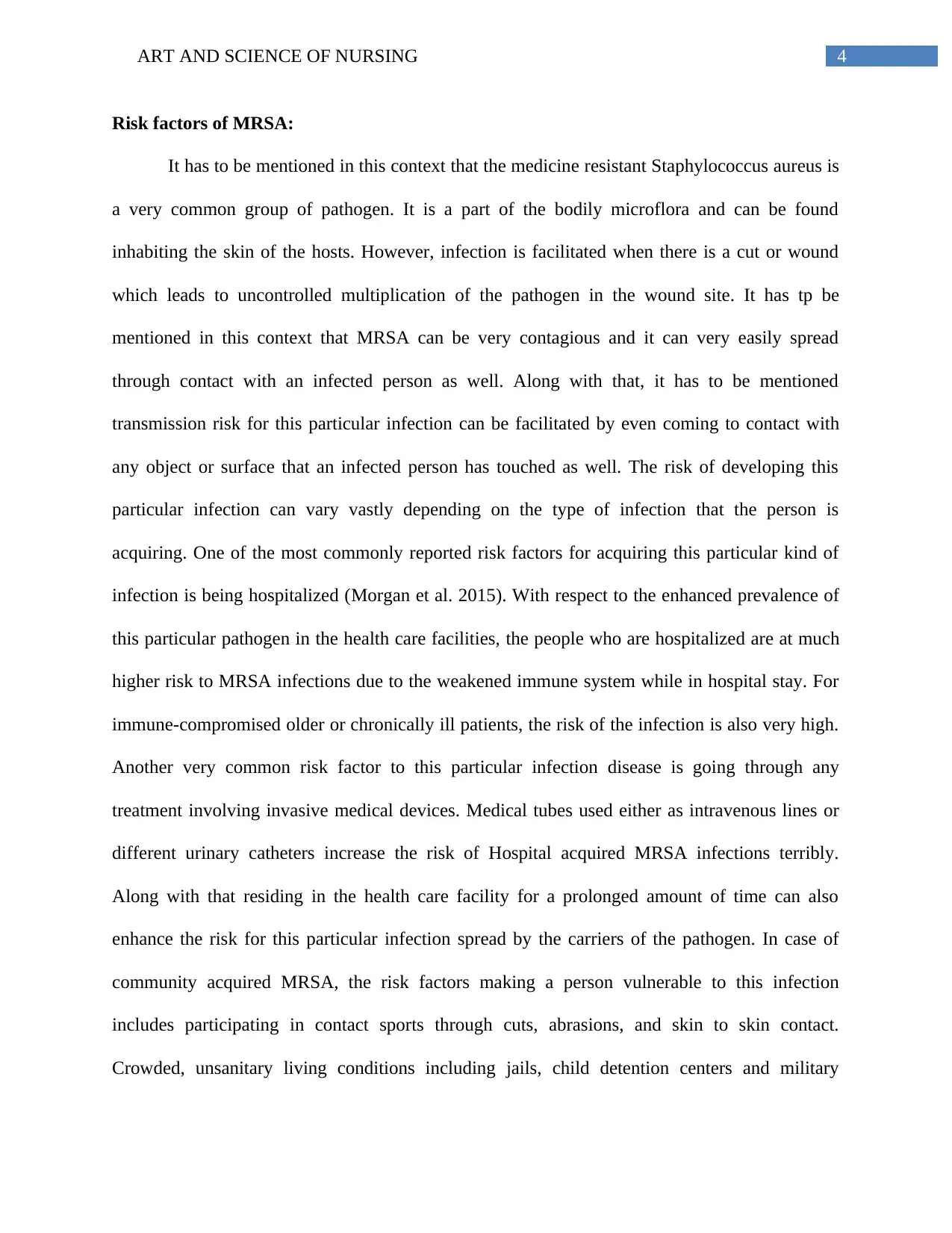
4ART AND SCIENCE OF NURSING
Risk factors of MRSA:
It has to be mentioned in this context that the medicine resistant Staphylococcus aureus is
a very common group of pathogen. It is a part of the bodily microflora and can be found
inhabiting the skin of the hosts. However, infection is facilitated when there is a cut or wound
which leads to uncontrolled multiplication of the pathogen in the wound site. It has tp be
mentioned in this context that MRSA can be very contagious and it can very easily spread
through contact with an infected person as well. Along with that, it has to be mentioned
transmission risk for this particular infection can be facilitated by even coming to contact with
any object or surface that an infected person has touched as well. The risk of developing this
particular infection can vary vastly depending on the type of infection that the person is
acquiring. One of the most commonly reported risk factors for acquiring this particular kind of
infection is being hospitalized (Morgan et al. 2015). With respect to the enhanced prevalence of
this particular pathogen in the health care facilities, the people who are hospitalized are at much
higher risk to MRSA infections due to the weakened immune system while in hospital stay. For
immune-compromised older or chronically ill patients, the risk of the infection is also very high.
Another very common risk factor to this particular infection disease is going through any
treatment involving invasive medical devices. Medical tubes used either as intravenous lines or
different urinary catheters increase the risk of Hospital acquired MRSA infections terribly.
Along with that residing in the health care facility for a prolonged amount of time can also
enhance the risk for this particular infection spread by the carriers of the pathogen. In case of
community acquired MRSA, the risk factors making a person vulnerable to this infection
includes participating in contact sports through cuts, abrasions, and skin to skin contact.
Crowded, unsanitary living conditions including jails, child detention centers and military
Risk factors of MRSA:
It has to be mentioned in this context that the medicine resistant Staphylococcus aureus is
a very common group of pathogen. It is a part of the bodily microflora and can be found
inhabiting the skin of the hosts. However, infection is facilitated when there is a cut or wound
which leads to uncontrolled multiplication of the pathogen in the wound site. It has tp be
mentioned in this context that MRSA can be very contagious and it can very easily spread
through contact with an infected person as well. Along with that, it has to be mentioned
transmission risk for this particular infection can be facilitated by even coming to contact with
any object or surface that an infected person has touched as well. The risk of developing this
particular infection can vary vastly depending on the type of infection that the person is
acquiring. One of the most commonly reported risk factors for acquiring this particular kind of
infection is being hospitalized (Morgan et al. 2015). With respect to the enhanced prevalence of
this particular pathogen in the health care facilities, the people who are hospitalized are at much
higher risk to MRSA infections due to the weakened immune system while in hospital stay. For
immune-compromised older or chronically ill patients, the risk of the infection is also very high.
Another very common risk factor to this particular infection disease is going through any
treatment involving invasive medical devices. Medical tubes used either as intravenous lines or
different urinary catheters increase the risk of Hospital acquired MRSA infections terribly.
Along with that residing in the health care facility for a prolonged amount of time can also
enhance the risk for this particular infection spread by the carriers of the pathogen. In case of
community acquired MRSA, the risk factors making a person vulnerable to this infection
includes participating in contact sports through cuts, abrasions, and skin to skin contact.
Crowded, unsanitary living conditions including jails, child detention centers and military
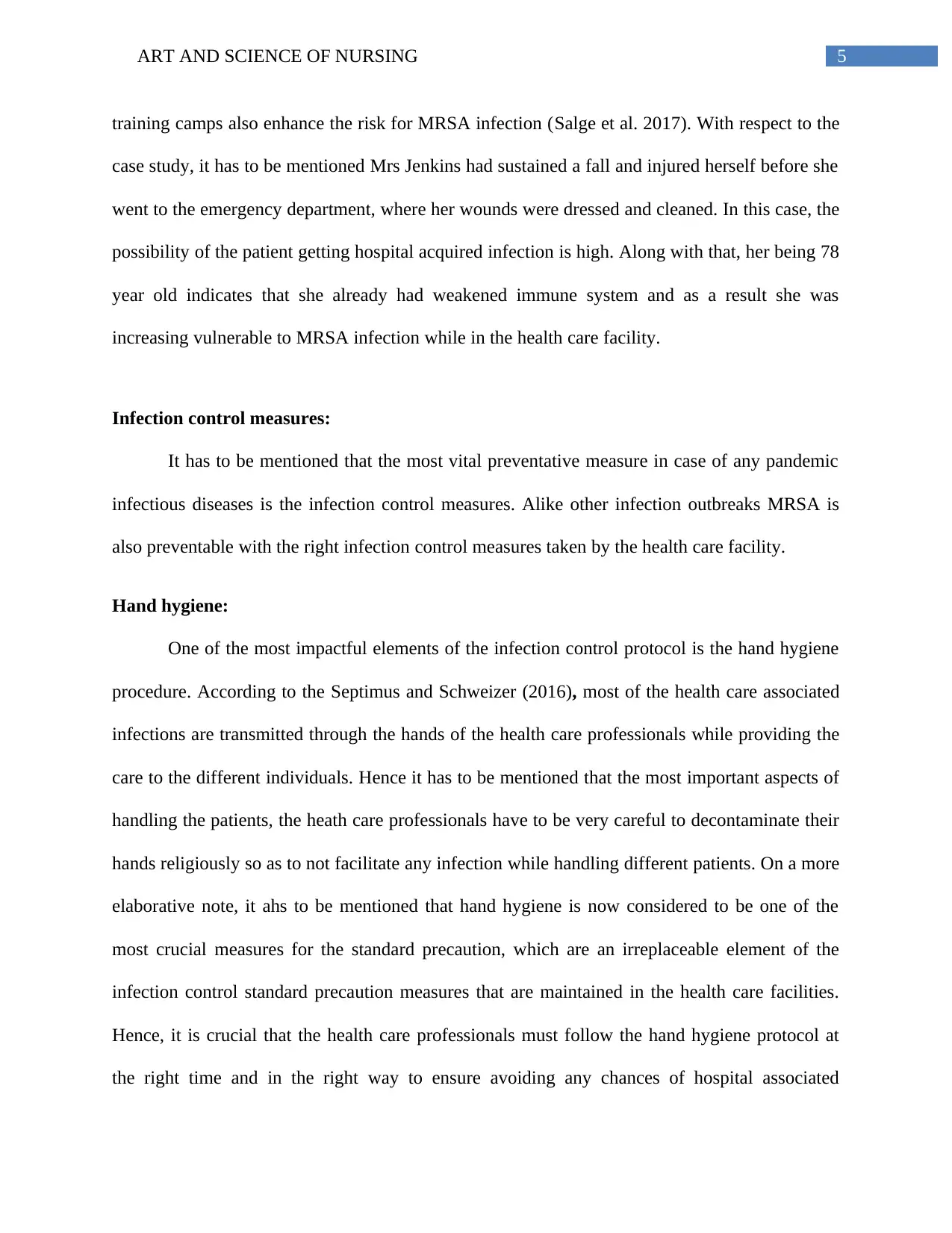
5ART AND SCIENCE OF NURSING
training camps also enhance the risk for MRSA infection (Salge et al. 2017). With respect to the
case study, it has to be mentioned Mrs Jenkins had sustained a fall and injured herself before she
went to the emergency department, where her wounds were dressed and cleaned. In this case, the
possibility of the patient getting hospital acquired infection is high. Along with that, her being 78
year old indicates that she already had weakened immune system and as a result she was
increasing vulnerable to MRSA infection while in the health care facility.
Infection control measures:
It has to be mentioned that the most vital preventative measure in case of any pandemic
infectious diseases is the infection control measures. Alike other infection outbreaks MRSA is
also preventable with the right infection control measures taken by the health care facility.
Hand hygiene:
One of the most impactful elements of the infection control protocol is the hand hygiene
procedure. According to the Septimus and Schweizer (2016), most of the health care associated
infections are transmitted through the hands of the health care professionals while providing the
care to the different individuals. Hence it has to be mentioned that the most important aspects of
handling the patients, the heath care professionals have to be very careful to decontaminate their
hands religiously so as to not facilitate any infection while handling different patients. On a more
elaborative note, it ahs to be mentioned that hand hygiene is now considered to be one of the
most crucial measures for the standard precaution, which are an irreplaceable element of the
infection control standard precaution measures that are maintained in the health care facilities.
Hence, it is crucial that the health care professionals must follow the hand hygiene protocol at
the right time and in the right way to ensure avoiding any chances of hospital associated
training camps also enhance the risk for MRSA infection (Salge et al. 2017). With respect to the
case study, it has to be mentioned Mrs Jenkins had sustained a fall and injured herself before she
went to the emergency department, where her wounds were dressed and cleaned. In this case, the
possibility of the patient getting hospital acquired infection is high. Along with that, her being 78
year old indicates that she already had weakened immune system and as a result she was
increasing vulnerable to MRSA infection while in the health care facility.
Infection control measures:
It has to be mentioned that the most vital preventative measure in case of any pandemic
infectious diseases is the infection control measures. Alike other infection outbreaks MRSA is
also preventable with the right infection control measures taken by the health care facility.
Hand hygiene:
One of the most impactful elements of the infection control protocol is the hand hygiene
procedure. According to the Septimus and Schweizer (2016), most of the health care associated
infections are transmitted through the hands of the health care professionals while providing the
care to the different individuals. Hence it has to be mentioned that the most important aspects of
handling the patients, the heath care professionals have to be very careful to decontaminate their
hands religiously so as to not facilitate any infection while handling different patients. On a more
elaborative note, it ahs to be mentioned that hand hygiene is now considered to be one of the
most crucial measures for the standard precaution, which are an irreplaceable element of the
infection control standard precaution measures that are maintained in the health care facilities.
Hence, it is crucial that the health care professionals must follow the hand hygiene protocol at
the right time and in the right way to ensure avoiding any chances of hospital associated
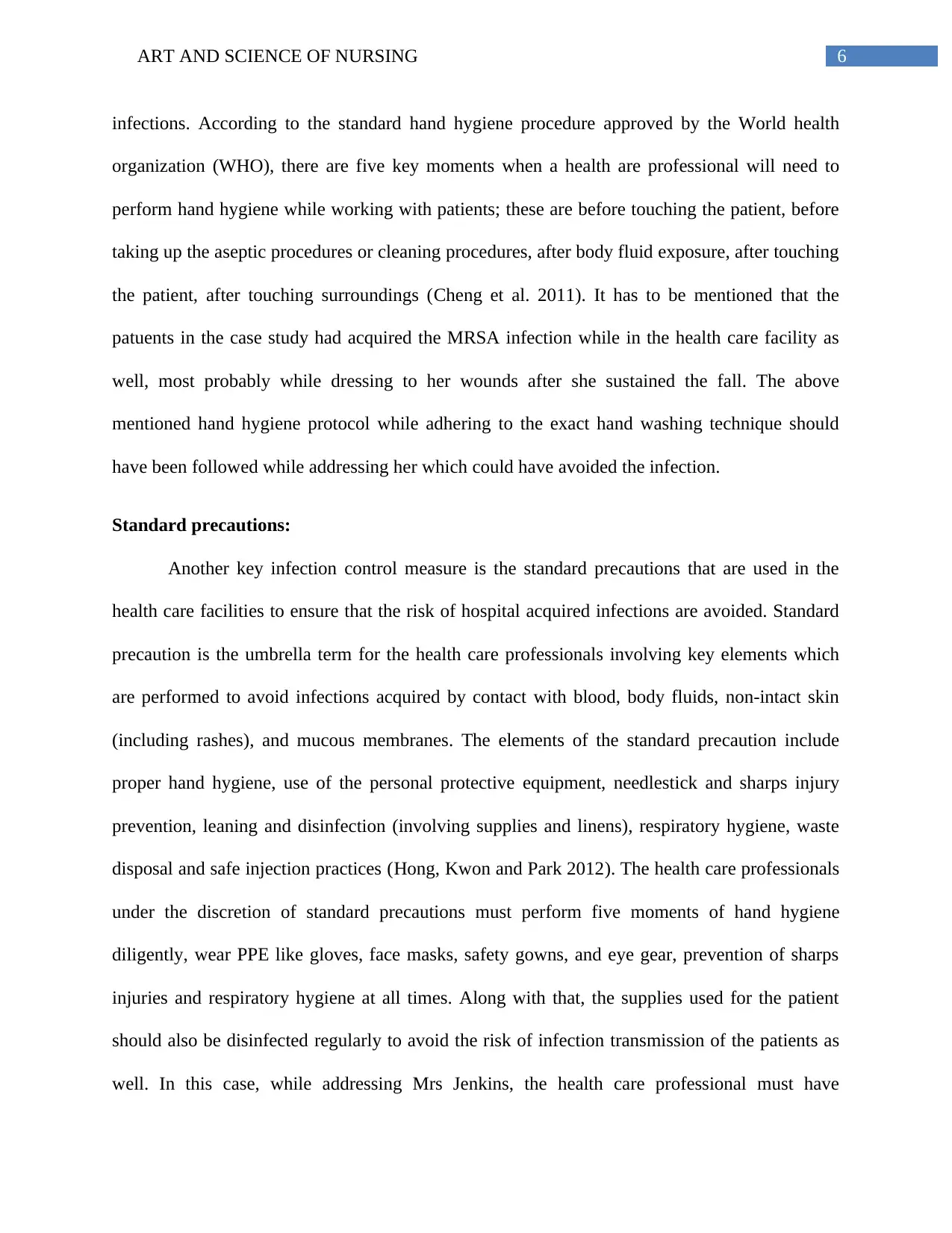
6ART AND SCIENCE OF NURSING
infections. According to the standard hand hygiene procedure approved by the World health
organization (WHO), there are five key moments when a health are professional will need to
perform hand hygiene while working with patients; these are before touching the patient, before
taking up the aseptic procedures or cleaning procedures, after body fluid exposure, after touching
the patient, after touching surroundings (Cheng et al. 2011). It has to be mentioned that the
patuents in the case study had acquired the MRSA infection while in the health care facility as
well, most probably while dressing to her wounds after she sustained the fall. The above
mentioned hand hygiene protocol while adhering to the exact hand washing technique should
have been followed while addressing her which could have avoided the infection.
Standard precautions:
Another key infection control measure is the standard precautions that are used in the
health care facilities to ensure that the risk of hospital acquired infections are avoided. Standard
precaution is the umbrella term for the health care professionals involving key elements which
are performed to avoid infections acquired by contact with blood, body fluids, non-intact skin
(including rashes), and mucous membranes. The elements of the standard precaution include
proper hand hygiene, use of the personal protective equipment, needlestick and sharps injury
prevention, leaning and disinfection (involving supplies and linens), respiratory hygiene, waste
disposal and safe injection practices (Hong, Kwon and Park 2012). The health care professionals
under the discretion of standard precautions must perform five moments of hand hygiene
diligently, wear PPE like gloves, face masks, safety gowns, and eye gear, prevention of sharps
injuries and respiratory hygiene at all times. Along with that, the supplies used for the patient
should also be disinfected regularly to avoid the risk of infection transmission of the patients as
well. In this case, while addressing Mrs Jenkins, the health care professional must have
infections. According to the standard hand hygiene procedure approved by the World health
organization (WHO), there are five key moments when a health are professional will need to
perform hand hygiene while working with patients; these are before touching the patient, before
taking up the aseptic procedures or cleaning procedures, after body fluid exposure, after touching
the patient, after touching surroundings (Cheng et al. 2011). It has to be mentioned that the
patuents in the case study had acquired the MRSA infection while in the health care facility as
well, most probably while dressing to her wounds after she sustained the fall. The above
mentioned hand hygiene protocol while adhering to the exact hand washing technique should
have been followed while addressing her which could have avoided the infection.
Standard precautions:
Another key infection control measure is the standard precautions that are used in the
health care facilities to ensure that the risk of hospital acquired infections are avoided. Standard
precaution is the umbrella term for the health care professionals involving key elements which
are performed to avoid infections acquired by contact with blood, body fluids, non-intact skin
(including rashes), and mucous membranes. The elements of the standard precaution include
proper hand hygiene, use of the personal protective equipment, needlestick and sharps injury
prevention, leaning and disinfection (involving supplies and linens), respiratory hygiene, waste
disposal and safe injection practices (Hong, Kwon and Park 2012). The health care professionals
under the discretion of standard precautions must perform five moments of hand hygiene
diligently, wear PPE like gloves, face masks, safety gowns, and eye gear, prevention of sharps
injuries and respiratory hygiene at all times. Along with that, the supplies used for the patient
should also be disinfected regularly to avoid the risk of infection transmission of the patients as
well. In this case, while addressing Mrs Jenkins, the health care professional must have
Paraphrase This Document
Need a fresh take? Get an instant paraphrase of this document with our AI Paraphraser
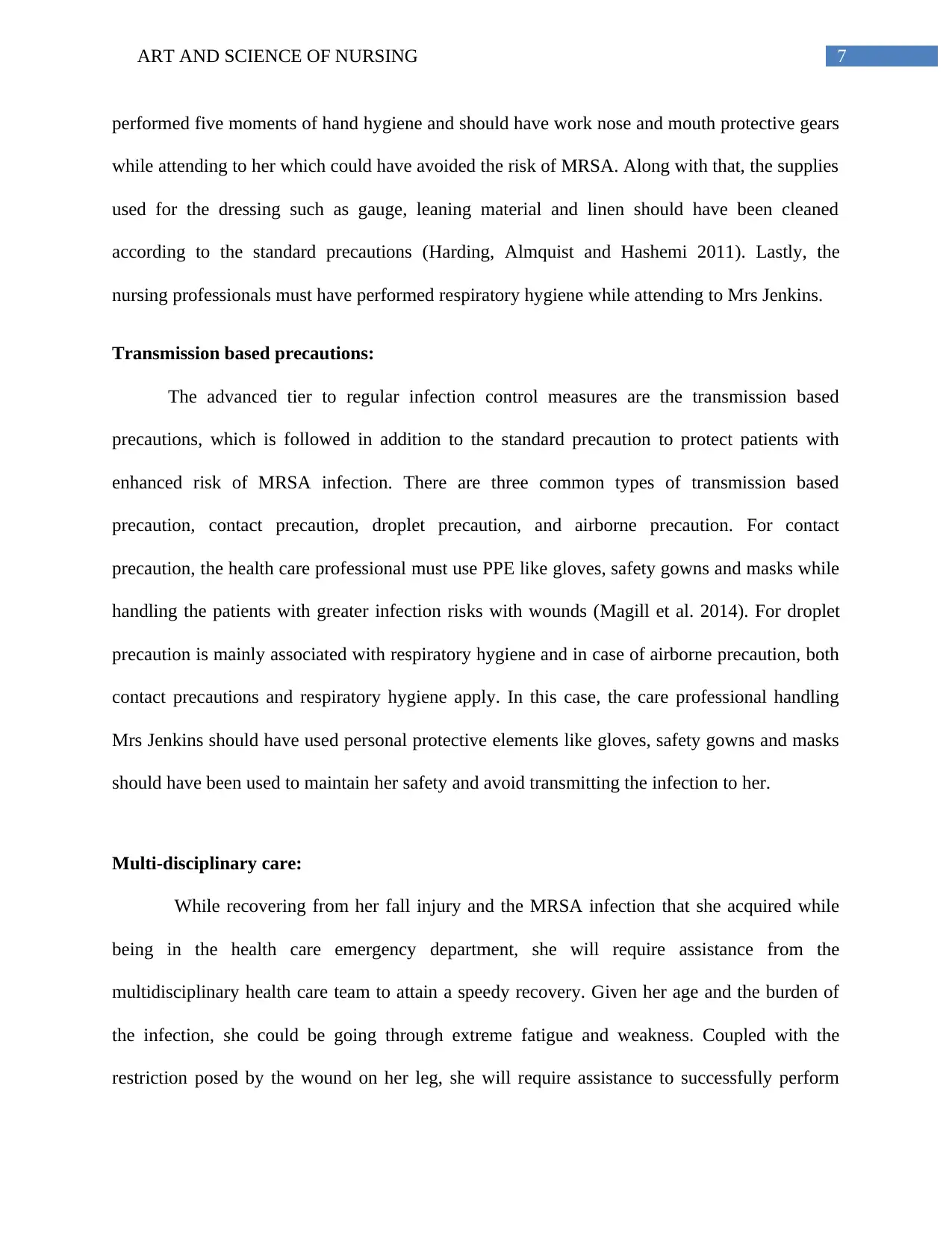
7ART AND SCIENCE OF NURSING
performed five moments of hand hygiene and should have work nose and mouth protective gears
while attending to her which could have avoided the risk of MRSA. Along with that, the supplies
used for the dressing such as gauge, leaning material and linen should have been cleaned
according to the standard precautions (Harding, Almquist and Hashemi 2011). Lastly, the
nursing professionals must have performed respiratory hygiene while attending to Mrs Jenkins.
Transmission based precautions:
The advanced tier to regular infection control measures are the transmission based
precautions, which is followed in addition to the standard precaution to protect patients with
enhanced risk of MRSA infection. There are three common types of transmission based
precaution, contact precaution, droplet precaution, and airborne precaution. For contact
precaution, the health care professional must use PPE like gloves, safety gowns and masks while
handling the patients with greater infection risks with wounds (Magill et al. 2014). For droplet
precaution is mainly associated with respiratory hygiene and in case of airborne precaution, both
contact precautions and respiratory hygiene apply. In this case, the care professional handling
Mrs Jenkins should have used personal protective elements like gloves, safety gowns and masks
should have been used to maintain her safety and avoid transmitting the infection to her.
Multi-disciplinary care:
While recovering from her fall injury and the MRSA infection that she acquired while
being in the health care emergency department, she will require assistance from the
multidisciplinary health care team to attain a speedy recovery. Given her age and the burden of
the infection, she could be going through extreme fatigue and weakness. Coupled with the
restriction posed by the wound on her leg, she will require assistance to successfully perform
performed five moments of hand hygiene and should have work nose and mouth protective gears
while attending to her which could have avoided the risk of MRSA. Along with that, the supplies
used for the dressing such as gauge, leaning material and linen should have been cleaned
according to the standard precautions (Harding, Almquist and Hashemi 2011). Lastly, the
nursing professionals must have performed respiratory hygiene while attending to Mrs Jenkins.
Transmission based precautions:
The advanced tier to regular infection control measures are the transmission based
precautions, which is followed in addition to the standard precaution to protect patients with
enhanced risk of MRSA infection. There are three common types of transmission based
precaution, contact precaution, droplet precaution, and airborne precaution. For contact
precaution, the health care professional must use PPE like gloves, safety gowns and masks while
handling the patients with greater infection risks with wounds (Magill et al. 2014). For droplet
precaution is mainly associated with respiratory hygiene and in case of airborne precaution, both
contact precautions and respiratory hygiene apply. In this case, the care professional handling
Mrs Jenkins should have used personal protective elements like gloves, safety gowns and masks
should have been used to maintain her safety and avoid transmitting the infection to her.
Multi-disciplinary care:
While recovering from her fall injury and the MRSA infection that she acquired while
being in the health care emergency department, she will require assistance from the
multidisciplinary health care team to attain a speedy recovery. Given her age and the burden of
the infection, she could be going through extreme fatigue and weakness. Coupled with the
restriction posed by the wound on her leg, she will require assistance to successfully perform
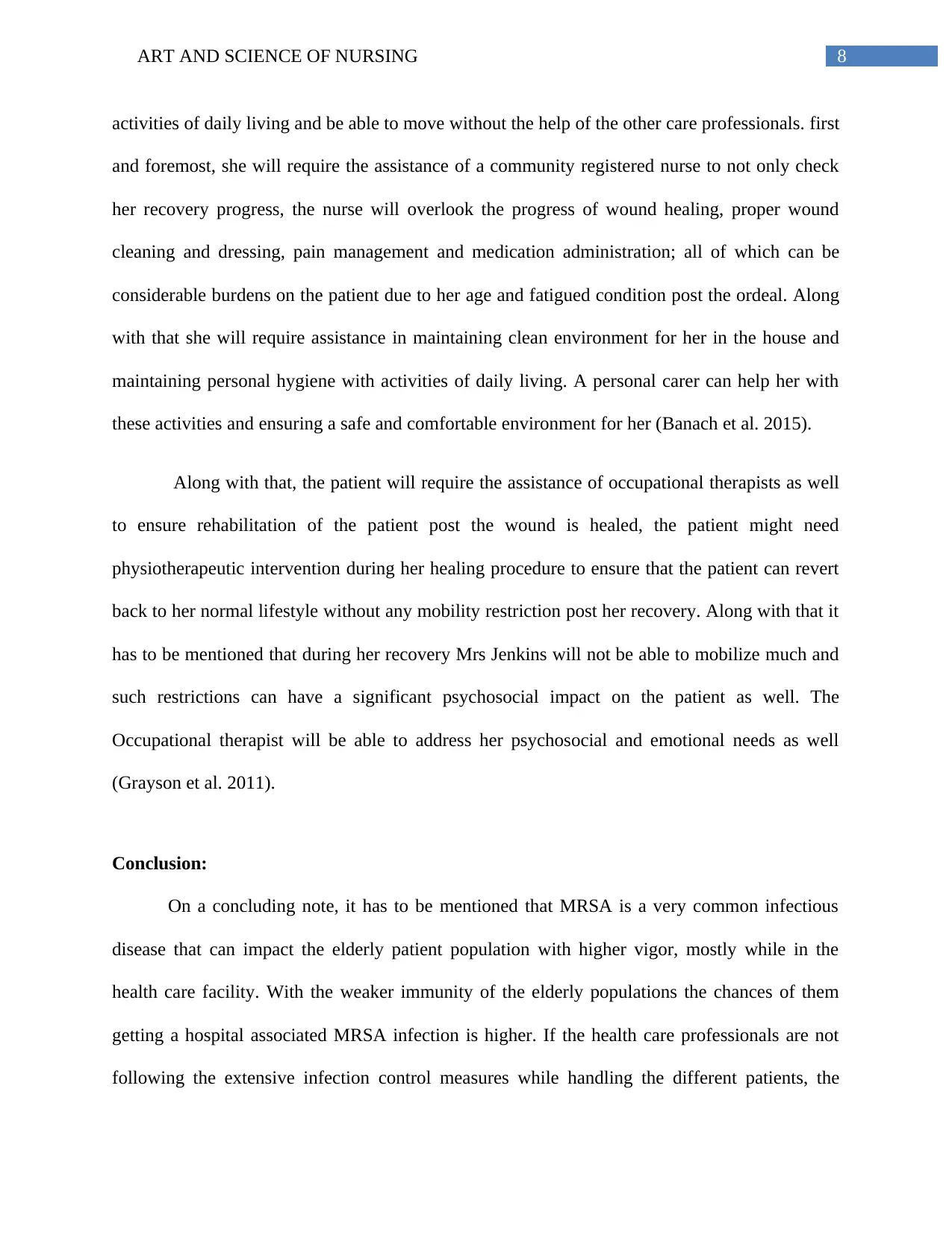
8ART AND SCIENCE OF NURSING
activities of daily living and be able to move without the help of the other care professionals. first
and foremost, she will require the assistance of a community registered nurse to not only check
her recovery progress, the nurse will overlook the progress of wound healing, proper wound
cleaning and dressing, pain management and medication administration; all of which can be
considerable burdens on the patient due to her age and fatigued condition post the ordeal. Along
with that she will require assistance in maintaining clean environment for her in the house and
maintaining personal hygiene with activities of daily living. A personal carer can help her with
these activities and ensuring a safe and comfortable environment for her (Banach et al. 2015).
Along with that, the patient will require the assistance of occupational therapists as well
to ensure rehabilitation of the patient post the wound is healed, the patient might need
physiotherapeutic intervention during her healing procedure to ensure that the patient can revert
back to her normal lifestyle without any mobility restriction post her recovery. Along with that it
has to be mentioned that during her recovery Mrs Jenkins will not be able to mobilize much and
such restrictions can have a significant psychosocial impact on the patient as well. The
Occupational therapist will be able to address her psychosocial and emotional needs as well
(Grayson et al. 2011).
Conclusion:
On a concluding note, it has to be mentioned that MRSA is a very common infectious
disease that can impact the elderly patient population with higher vigor, mostly while in the
health care facility. With the weaker immunity of the elderly populations the chances of them
getting a hospital associated MRSA infection is higher. If the health care professionals are not
following the extensive infection control measures while handling the different patients, the
activities of daily living and be able to move without the help of the other care professionals. first
and foremost, she will require the assistance of a community registered nurse to not only check
her recovery progress, the nurse will overlook the progress of wound healing, proper wound
cleaning and dressing, pain management and medication administration; all of which can be
considerable burdens on the patient due to her age and fatigued condition post the ordeal. Along
with that she will require assistance in maintaining clean environment for her in the house and
maintaining personal hygiene with activities of daily living. A personal carer can help her with
these activities and ensuring a safe and comfortable environment for her (Banach et al. 2015).
Along with that, the patient will require the assistance of occupational therapists as well
to ensure rehabilitation of the patient post the wound is healed, the patient might need
physiotherapeutic intervention during her healing procedure to ensure that the patient can revert
back to her normal lifestyle without any mobility restriction post her recovery. Along with that it
has to be mentioned that during her recovery Mrs Jenkins will not be able to mobilize much and
such restrictions can have a significant psychosocial impact on the patient as well. The
Occupational therapist will be able to address her psychosocial and emotional needs as well
(Grayson et al. 2011).
Conclusion:
On a concluding note, it has to be mentioned that MRSA is a very common infectious
disease that can impact the elderly patient population with higher vigor, mostly while in the
health care facility. With the weaker immunity of the elderly populations the chances of them
getting a hospital associated MRSA infection is higher. If the health care professionals are not
following the extensive infection control measures while handling the different patients, the
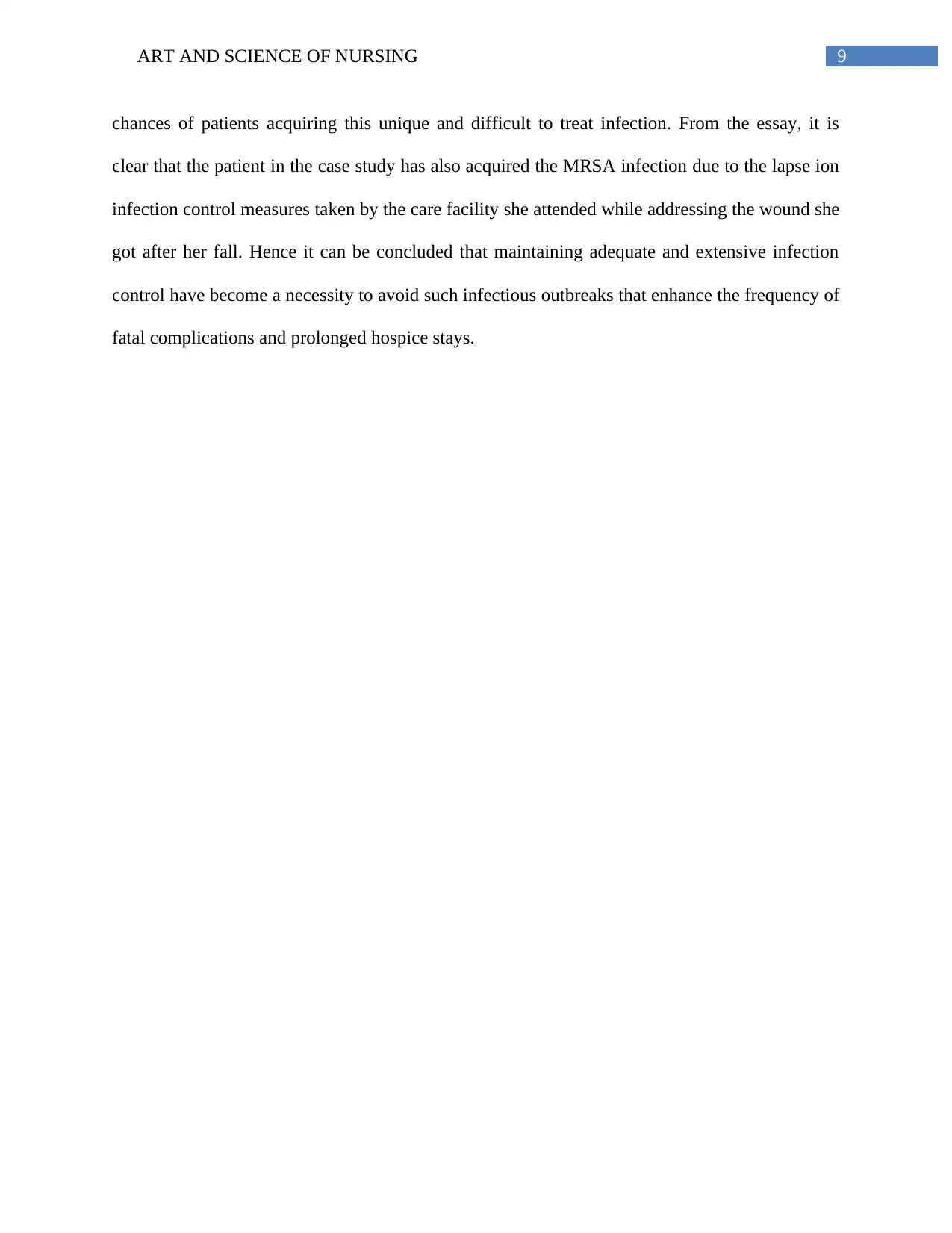
9ART AND SCIENCE OF NURSING
chances of patients acquiring this unique and difficult to treat infection. From the essay, it is
clear that the patient in the case study has also acquired the MRSA infection due to the lapse ion
infection control measures taken by the care facility she attended while addressing the wound she
got after her fall. Hence it can be concluded that maintaining adequate and extensive infection
control have become a necessity to avoid such infectious outbreaks that enhance the frequency of
fatal complications and prolonged hospice stays.
chances of patients acquiring this unique and difficult to treat infection. From the essay, it is
clear that the patient in the case study has also acquired the MRSA infection due to the lapse ion
infection control measures taken by the care facility she attended while addressing the wound she
got after her fall. Hence it can be concluded that maintaining adequate and extensive infection
control have become a necessity to avoid such infectious outbreaks that enhance the frequency of
fatal complications and prolonged hospice stays.
Secure Best Marks with AI Grader
Need help grading? Try our AI Grader for instant feedback on your assignments.
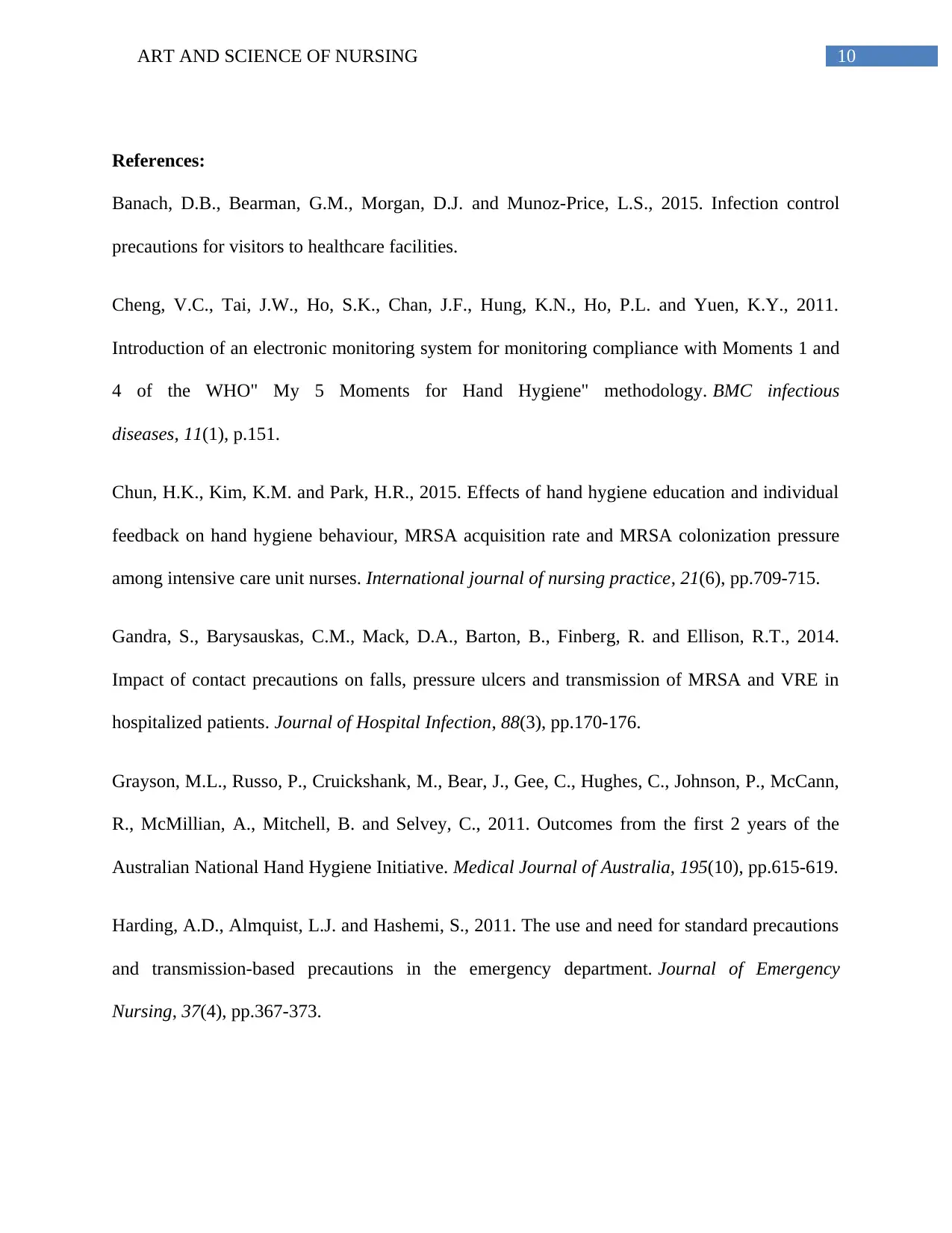
10ART AND SCIENCE OF NURSING
References:
Banach, D.B., Bearman, G.M., Morgan, D.J. and Munoz-Price, L.S., 2015. Infection control
precautions for visitors to healthcare facilities.
Cheng, V.C., Tai, J.W., Ho, S.K., Chan, J.F., Hung, K.N., Ho, P.L. and Yuen, K.Y., 2011.
Introduction of an electronic monitoring system for monitoring compliance with Moments 1 and
4 of the WHO" My 5 Moments for Hand Hygiene" methodology. BMC infectious
diseases, 11(1), p.151.
Chun, H.K., Kim, K.M. and Park, H.R., 2015. Effects of hand hygiene education and individual
feedback on hand hygiene behaviour, MRSA acquisition rate and MRSA colonization pressure
among intensive care unit nurses. International journal of nursing practice, 21(6), pp.709-715.
Gandra, S., Barysauskas, C.M., Mack, D.A., Barton, B., Finberg, R. and Ellison, R.T., 2014.
Impact of contact precautions on falls, pressure ulcers and transmission of MRSA and VRE in
hospitalized patients. Journal of Hospital Infection, 88(3), pp.170-176.
Grayson, M.L., Russo, P., Cruickshank, M., Bear, J., Gee, C., Hughes, C., Johnson, P., McCann,
R., McMillian, A., Mitchell, B. and Selvey, C., 2011. Outcomes from the first 2 years of the
Australian National Hand Hygiene Initiative. Medical Journal of Australia, 195(10), pp.615-619.
Harding, A.D., Almquist, L.J. and Hashemi, S., 2011. The use and need for standard precautions
and transmission-based precautions in the emergency department. Journal of Emergency
Nursing, 37(4), pp.367-373.
References:
Banach, D.B., Bearman, G.M., Morgan, D.J. and Munoz-Price, L.S., 2015. Infection control
precautions for visitors to healthcare facilities.
Cheng, V.C., Tai, J.W., Ho, S.K., Chan, J.F., Hung, K.N., Ho, P.L. and Yuen, K.Y., 2011.
Introduction of an electronic monitoring system for monitoring compliance with Moments 1 and
4 of the WHO" My 5 Moments for Hand Hygiene" methodology. BMC infectious
diseases, 11(1), p.151.
Chun, H.K., Kim, K.M. and Park, H.R., 2015. Effects of hand hygiene education and individual
feedback on hand hygiene behaviour, MRSA acquisition rate and MRSA colonization pressure
among intensive care unit nurses. International journal of nursing practice, 21(6), pp.709-715.
Gandra, S., Barysauskas, C.M., Mack, D.A., Barton, B., Finberg, R. and Ellison, R.T., 2014.
Impact of contact precautions on falls, pressure ulcers and transmission of MRSA and VRE in
hospitalized patients. Journal of Hospital Infection, 88(3), pp.170-176.
Grayson, M.L., Russo, P., Cruickshank, M., Bear, J., Gee, C., Hughes, C., Johnson, P., McCann,
R., McMillian, A., Mitchell, B. and Selvey, C., 2011. Outcomes from the first 2 years of the
Australian National Hand Hygiene Initiative. Medical Journal of Australia, 195(10), pp.615-619.
Harding, A.D., Almquist, L.J. and Hashemi, S., 2011. The use and need for standard precautions
and transmission-based precautions in the emergency department. Journal of Emergency
Nursing, 37(4), pp.367-373.
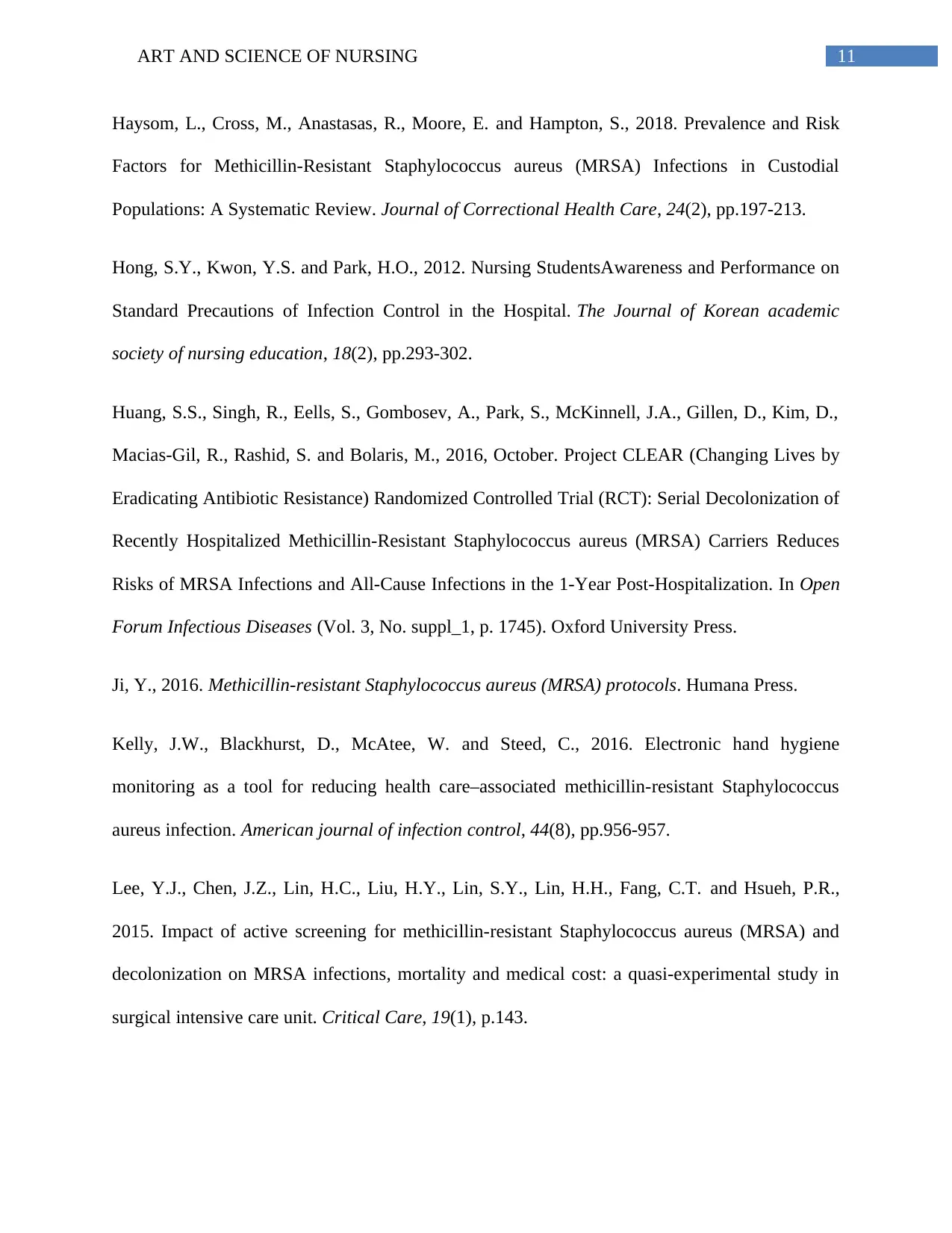
11ART AND SCIENCE OF NURSING
Haysom, L., Cross, M., Anastasas, R., Moore, E. and Hampton, S., 2018. Prevalence and Risk
Factors for Methicillin-Resistant Staphylococcus aureus (MRSA) Infections in Custodial
Populations: A Systematic Review. Journal of Correctional Health Care, 24(2), pp.197-213.
Hong, S.Y., Kwon, Y.S. and Park, H.O., 2012. Nursing StudentsAwareness and Performance on
Standard Precautions of Infection Control in the Hospital. The Journal of Korean academic
society of nursing education, 18(2), pp.293-302.
Huang, S.S., Singh, R., Eells, S., Gombosev, A., Park, S., McKinnell, J.A., Gillen, D., Kim, D.,
Macias-Gil, R., Rashid, S. and Bolaris, M., 2016, October. Project CLEAR (Changing Lives by
Eradicating Antibiotic Resistance) Randomized Controlled Trial (RCT): Serial Decolonization of
Recently Hospitalized Methicillin-Resistant Staphylococcus aureus (MRSA) Carriers Reduces
Risks of MRSA Infections and All-Cause Infections in the 1-Year Post-Hospitalization. In Open
Forum Infectious Diseases (Vol. 3, No. suppl_1, p. 1745). Oxford University Press.
Ji, Y., 2016. Methicillin-resistant Staphylococcus aureus (MRSA) protocols. Humana Press.
Kelly, J.W., Blackhurst, D., McAtee, W. and Steed, C., 2016. Electronic hand hygiene
monitoring as a tool for reducing health care–associated methicillin-resistant Staphylococcus
aureus infection. American journal of infection control, 44(8), pp.956-957.
Lee, Y.J., Chen, J.Z., Lin, H.C., Liu, H.Y., Lin, S.Y., Lin, H.H., Fang, C.T. and Hsueh, P.R.,
2015. Impact of active screening for methicillin-resistant Staphylococcus aureus (MRSA) and
decolonization on MRSA infections, mortality and medical cost: a quasi-experimental study in
surgical intensive care unit. Critical Care, 19(1), p.143.
Haysom, L., Cross, M., Anastasas, R., Moore, E. and Hampton, S., 2018. Prevalence and Risk
Factors for Methicillin-Resistant Staphylococcus aureus (MRSA) Infections in Custodial
Populations: A Systematic Review. Journal of Correctional Health Care, 24(2), pp.197-213.
Hong, S.Y., Kwon, Y.S. and Park, H.O., 2012. Nursing StudentsAwareness and Performance on
Standard Precautions of Infection Control in the Hospital. The Journal of Korean academic
society of nursing education, 18(2), pp.293-302.
Huang, S.S., Singh, R., Eells, S., Gombosev, A., Park, S., McKinnell, J.A., Gillen, D., Kim, D.,
Macias-Gil, R., Rashid, S. and Bolaris, M., 2016, October. Project CLEAR (Changing Lives by
Eradicating Antibiotic Resistance) Randomized Controlled Trial (RCT): Serial Decolonization of
Recently Hospitalized Methicillin-Resistant Staphylococcus aureus (MRSA) Carriers Reduces
Risks of MRSA Infections and All-Cause Infections in the 1-Year Post-Hospitalization. In Open
Forum Infectious Diseases (Vol. 3, No. suppl_1, p. 1745). Oxford University Press.
Ji, Y., 2016. Methicillin-resistant Staphylococcus aureus (MRSA) protocols. Humana Press.
Kelly, J.W., Blackhurst, D., McAtee, W. and Steed, C., 2016. Electronic hand hygiene
monitoring as a tool for reducing health care–associated methicillin-resistant Staphylococcus
aureus infection. American journal of infection control, 44(8), pp.956-957.
Lee, Y.J., Chen, J.Z., Lin, H.C., Liu, H.Y., Lin, S.Y., Lin, H.H., Fang, C.T. and Hsueh, P.R.,
2015. Impact of active screening for methicillin-resistant Staphylococcus aureus (MRSA) and
decolonization on MRSA infections, mortality and medical cost: a quasi-experimental study in
surgical intensive care unit. Critical Care, 19(1), p.143.
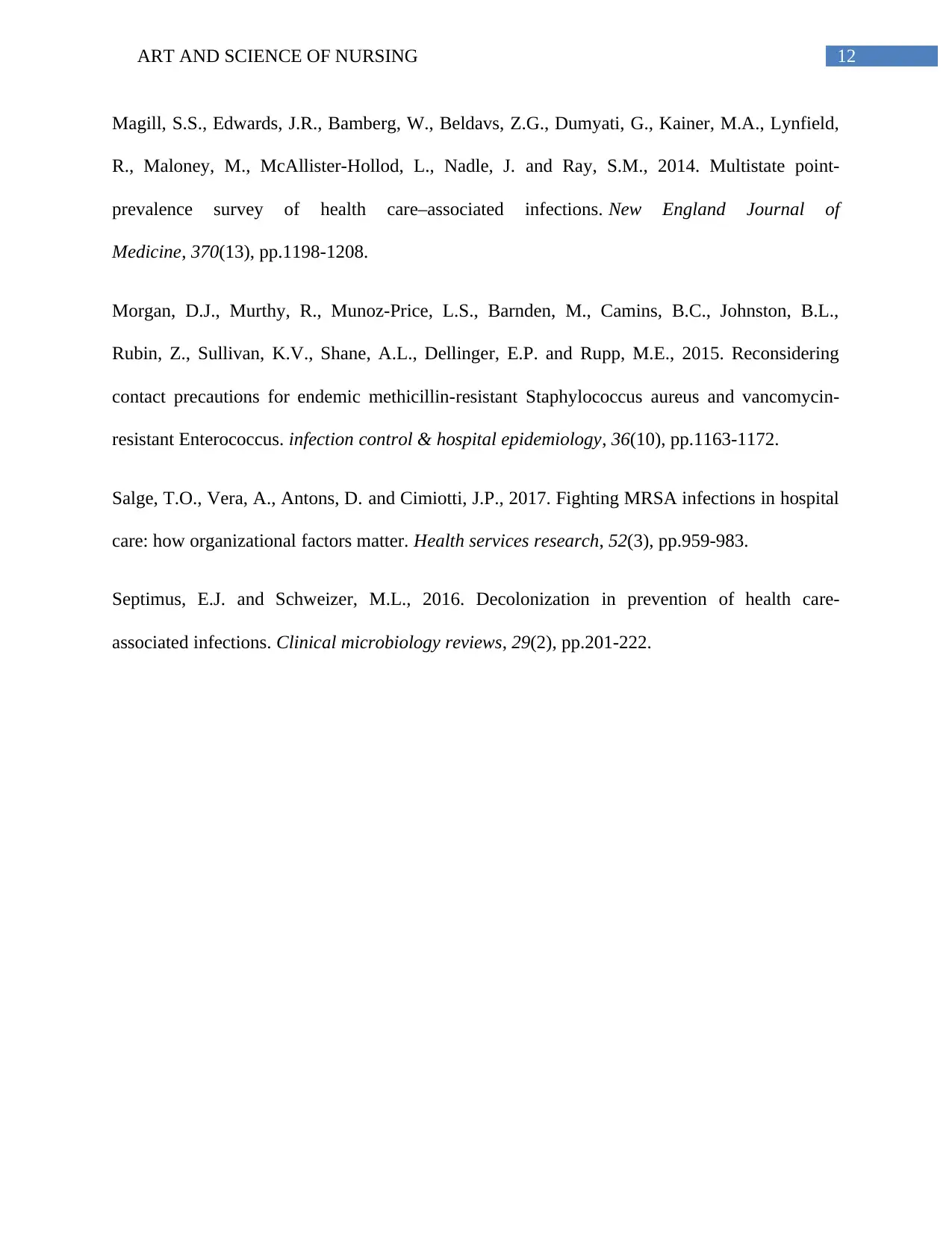
12ART AND SCIENCE OF NURSING
Magill, S.S., Edwards, J.R., Bamberg, W., Beldavs, Z.G., Dumyati, G., Kainer, M.A., Lynfield,
R., Maloney, M., McAllister-Hollod, L., Nadle, J. and Ray, S.M., 2014. Multistate point-
prevalence survey of health care–associated infections. New England Journal of
Medicine, 370(13), pp.1198-1208.
Morgan, D.J., Murthy, R., Munoz-Price, L.S., Barnden, M., Camins, B.C., Johnston, B.L.,
Rubin, Z., Sullivan, K.V., Shane, A.L., Dellinger, E.P. and Rupp, M.E., 2015. Reconsidering
contact precautions for endemic methicillin-resistant Staphylococcus aureus and vancomycin-
resistant Enterococcus. infection control & hospital epidemiology, 36(10), pp.1163-1172.
Salge, T.O., Vera, A., Antons, D. and Cimiotti, J.P., 2017. Fighting MRSA infections in hospital
care: how organizational factors matter. Health services research, 52(3), pp.959-983.
Septimus, E.J. and Schweizer, M.L., 2016. Decolonization in prevention of health care-
associated infections. Clinical microbiology reviews, 29(2), pp.201-222.
Magill, S.S., Edwards, J.R., Bamberg, W., Beldavs, Z.G., Dumyati, G., Kainer, M.A., Lynfield,
R., Maloney, M., McAllister-Hollod, L., Nadle, J. and Ray, S.M., 2014. Multistate point-
prevalence survey of health care–associated infections. New England Journal of
Medicine, 370(13), pp.1198-1208.
Morgan, D.J., Murthy, R., Munoz-Price, L.S., Barnden, M., Camins, B.C., Johnston, B.L.,
Rubin, Z., Sullivan, K.V., Shane, A.L., Dellinger, E.P. and Rupp, M.E., 2015. Reconsidering
contact precautions for endemic methicillin-resistant Staphylococcus aureus and vancomycin-
resistant Enterococcus. infection control & hospital epidemiology, 36(10), pp.1163-1172.
Salge, T.O., Vera, A., Antons, D. and Cimiotti, J.P., 2017. Fighting MRSA infections in hospital
care: how organizational factors matter. Health services research, 52(3), pp.959-983.
Septimus, E.J. and Schweizer, M.L., 2016. Decolonization in prevention of health care-
associated infections. Clinical microbiology reviews, 29(2), pp.201-222.
1 out of 13
Related Documents
Your All-in-One AI-Powered Toolkit for Academic Success.
+13062052269
info@desklib.com
Available 24*7 on WhatsApp / Email
![[object Object]](/_next/static/media/star-bottom.7253800d.svg)
Unlock your academic potential
© 2024 | Zucol Services PVT LTD | All rights reserved.





